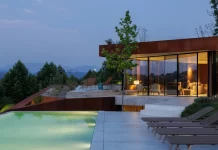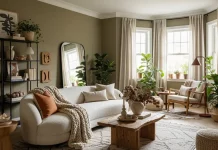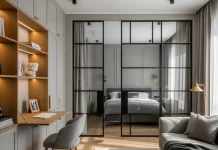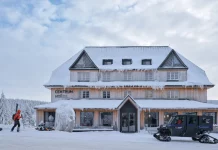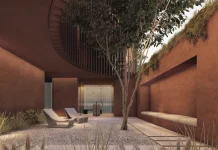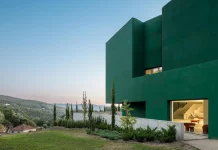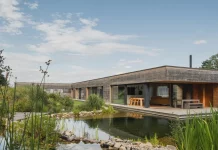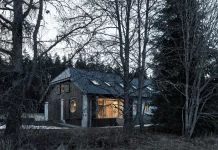At first glance, Casa M seems beautifully simple. From the street, it presents a clean, single-story volume, clad in warm wood. It feels modest, private, and incredibly elegant. But this initial view is a clever, architectural illusion. It’s a quiet introduction to a home that holds a brilliant secret. This project, brought to life by the visionaries at Silverline architecture atelier and captured through the lens of Ivo Tavares, isn’t just built on a piece of land. It’s in a deep, meaningful conversation with it. The design tackles a steep, 3-meter slope not as a problem to be solved, but as an opportunity to create something truly extraordinary.
This home challenges our perception of space. It asks us to look closer, to understand that what we see on the surface is only half the story. It uses the terrain’s own contours to create a dynamic living experience spread across two distinct, yet seamlessly connected, levels. What if a home could be both a private sanctuary and an open invitation to the outdoors, all at once? Casa M provides a stunning answer.

The Genius Behind the Split-Level Design of Casa M
The core challenge for the architects was the plot’s significant slope. A conventional build might have involved massive excavation, fighting against the natural lay of the land. Silverline, however, chose a more harmonious path. They embraced the topography by implementing a “split-level” system. Think of it as a house with two personalities, perfectly balanced.
From the public road, Casa M maintains a low profile. The pedestrian and vehicle entrances are located on this upper street level, leading you into what feels like a complete home. This upper half-floor cleverly houses the most private areas of the residence. But here is where the magic happens. A separate set of stairs leads you down to a lower half-floor, the social heart of the home, which sits at the natural ground level of the rear garden.
Although technically designated as “floor-1,” none of these social spaces is underground, far from it. This entire lower level opens up to the east, south, and west. Sunlight pours in. Fresh air circulates freely. The design masterfully uses the slope to its advantage, nesting the home into the hillside. This integration ensures the building feels like a natural extension of the landscape, not an imposition upon it. It’s a brilliant solution for anyone wondering how to design a house on a sloped lot without compromising on light or connection to the outdoors.
A Tale of Two Floors: Private Sanctuaries and Social Hubs
The home’s programmatic layout is a masterclass in organization, creating a clear and intuitive flow. When you step inside Casa M, an entrance hall acts as the central nervous system, distributing movement throughout the home.
On this same entrance level, you find immediate practicalities. There is a covered garage with room for three vehicles, a technical area, and a versatile guest room that doubles as a home office, complete with its own private bathroom. The true private sanctuaries, however, are found on this upper half-floor. Here, a master suite and two smaller suites offer complete tranquility. Each one is a self-contained retreat with a bathroom, a walk-in closet, a bedroom, and a private balcony. To unify this entire upper volume, everything, including the garage doors, is clad in vertical solid wood slats. This choice creates a visually seamless façade, lending the home a warm, inviting, and distinctly contemporary character.
Descending to the lower level feels like entering another world. This floor is dedicated entirely to leisure and social connection. The design erases the boundaries between inside and out through vast glazed openings. These glass walls lead to two covered terraces, which serve as transitional spaces to the garden and a stunning swimming pool. This level is where life is shared.
A Seamless Social Space
The social areas of Casa M were conceived as a single, flowing space. The living room, dining area, and kitchen all coexist in an open-plan layout. The transition between them is subtle, almost imperceptible. This sense of continuity is reinforced by a uniform palette of materials. Gorgeous wood furniture echoes the exterior cladding, while a sleek microcement floor runs throughout, creating an unbroken visual plane that enhances the feeling of spaciousness.
But what about when you need a bit more separation? The design has an answer for that, too. Two large wooden panels can slide into place, closing the gap between the living room and kitchen. This allows the residents to adjust the level of openness and privacy on a whim. It’s a flexible solution for a dynamic, modern lifestyle.
The kitchen itself is a piece of minimalist art. Silverline designed it with another panel system. When these panels are closed, they completely conceal all the functional elements—cabinets, countertops, appliances, and utensils disappear. The kitchen transforms into a clean, sculptural part of the living space, reinforcing the home’s multifunctional character. This is a perfect example of minimalist kitchen design with hidden appliances, where form and function exist in perfect harmony.
A Symphony of Natural Materials in Construction
Ultimately, Casa M is a testament to contemporary residential architecture that prioritizes a deep connection to nature. The project stands out for its masterful interplay of materials. The robust, grounding presence of exposed concrete provides the home’s structural and visual anchor. This is softened by the extensive use of warm, natural wood, which adds texture and a human touch. Finally, elegant stone elements tie the composition together, creating a rich and tactile experience.
This combination of materials gives the construction a character that is at once strong and sophisticated. The large glass openings do more than just frame the views; they dissolve the barrier between the carefully curated interiors and the lush exterior. The design of Casa M by Silverline architecture atelier emphasizes spaciousness, flow, and function.
It’s a home that feels both welcoming and inspiring. It proves that with thoughtful design, a challenging site can become a source of immense architectural beauty. It leaves you with a final, lingering question: How much better could our living spaces be if they learned to listen to the land they occupy?
All images © Ivo Tavares. Feel free to browse WE AND THE COLOR’s Architecture and Interior Design categories for more inspiring projects from around the globe.




